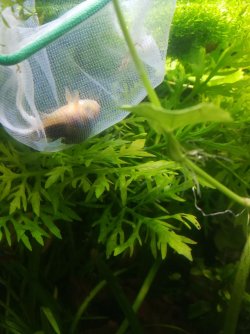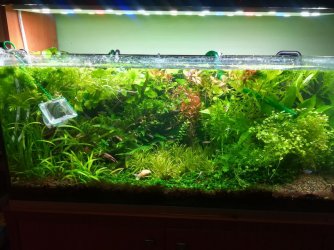I have 4 corydoras - 2 pairs, 2 peppered and 2 albino in an 180 liters tank, together with 2 ancistrus, 5 SAE, 10 werners, one otto and about 20 neeons. I have had the corries since they were young, 3-4 years ago.
4 days ago I found one of the peppered ones (the female) laying on the bottom belly up. First I thought it was dead, but realized its gills were moving. I tried to poke her up, but she laid there. For 2 days I have lifted her in a net close to the water surface and tried to give her some food - sadly without success. There is no improvement, and I think she is just starving, as her stomach gradually sank in, and it breaks my heart to see her like that. She follows my movements with her eyes, as corries do, but other than that and fin twitching, she doesn't move at all. I tried treating the tank with a general medication - which I used in the past whenever one of my fishes looked a bit down (Multicura from Easy Life), but no improvement has happened. There are no other external signs of sickness that I can tell. I asked on couple of forums if there is any treatment, but got no answer. Right now I am considering putting an end to the poor fish misery - I read about clove oil though I never had to do that to a fish before, but I am asking here as a last hope.
As I assume you will ask me about water parameters, currently I only have some of those sticks sets from Easy Life, but they don't show anything out of the ordinary - ammonia and nitrites 0, nitrates around 20-40. The tank is heavily planted, setup is 2 years old. It has 2 external filters - one Eheim 350 professionel and one JBL e700. It has co2 and I dose fertilizers by an automated pump according to producer's label.
I did have some new additions to the tank recently: 3 ottos, out of which only one seems to have survived sadly (ordered 5, 2 died during transportation, 2 more after about a week) and the werners. Since I heard ottos are wild caught, I'm wondering if they could have come with something nasty. None of the other fish seem to have issues.
4 days ago I found one of the peppered ones (the female) laying on the bottom belly up. First I thought it was dead, but realized its gills were moving. I tried to poke her up, but she laid there. For 2 days I have lifted her in a net close to the water surface and tried to give her some food - sadly without success. There is no improvement, and I think she is just starving, as her stomach gradually sank in, and it breaks my heart to see her like that. She follows my movements with her eyes, as corries do, but other than that and fin twitching, she doesn't move at all. I tried treating the tank with a general medication - which I used in the past whenever one of my fishes looked a bit down (Multicura from Easy Life), but no improvement has happened. There are no other external signs of sickness that I can tell. I asked on couple of forums if there is any treatment, but got no answer. Right now I am considering putting an end to the poor fish misery - I read about clove oil though I never had to do that to a fish before, but I am asking here as a last hope.
As I assume you will ask me about water parameters, currently I only have some of those sticks sets from Easy Life, but they don't show anything out of the ordinary - ammonia and nitrites 0, nitrates around 20-40. The tank is heavily planted, setup is 2 years old. It has 2 external filters - one Eheim 350 professionel and one JBL e700. It has co2 and I dose fertilizers by an automated pump according to producer's label.
I did have some new additions to the tank recently: 3 ottos, out of which only one seems to have survived sadly (ordered 5, 2 died during transportation, 2 more after about a week) and the werners. Since I heard ottos are wild caught, I'm wondering if they could have come with something nasty. None of the other fish seem to have issues.




